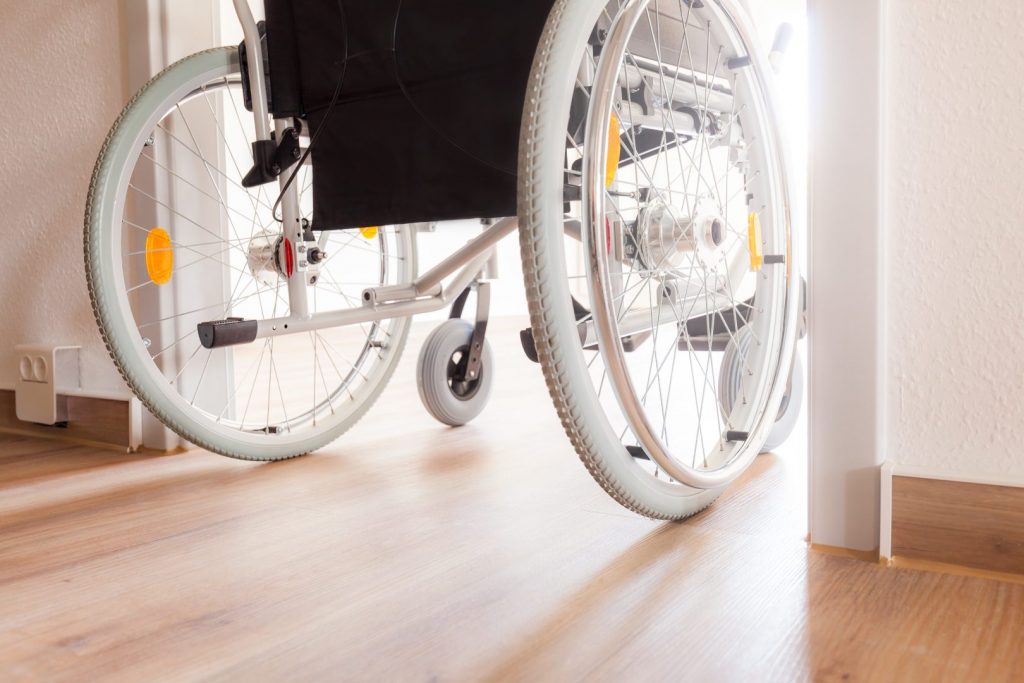
This doorway is wide enough for a wheelchair to pass through it making it an aging in place treatment that is also universal design – an instance when both design strategies are the same
Aging in place and universal design are two terms that are frequently used when discussed modifications, renovations, or residential building to make those dwelling more accessible and functional. Are they the same? Are they interchangeable? Can we use either term, or is there a key distinction?
While aging in place as a strategy for modifying and equipping homes to facilitate better utilization and function within that space by the current residents and universal design as a concept for treating those same spaces or even incorporating it into new construction are closely related, they are very different at the same time. Their purposes and directions are different.
Aging in place is a design strategy or approach that focuses on making a dwelling – specific to the individual or individuals in that living space – safe, comfortable, accessible, and enjoyable so that they can live independently in that home for the rest of their lives (unless a serious medical issue forces relocation to a hospital, rehab center, or memory care facility).
Some people choose to move from the home they are in rather than trying to modify their current space and opt for a different floor plan that they believe can accommodate them long-term (one-level, easier entry and navigation, more storage, newer design, more technology features, smaller and more compact, or other advantageous features). While this is technically aging in place because the real issue is wherever someone is that aging in place occurs where someone is residing, it’s beyond the spirit of aging in place which is to modify or otherwise address issues in someone’s current home so that moving from it is unnecessary and the occupants can maintain safe and viable lifestyles in their present homes for the rest of their days.
Universal design is a type of design strategy or concept that attempts to make features in the home usable by and accessible by anyone living in the home (regardless of age, size, physical strength, mobility, sensory capacity, cognition, or other considerations) as well as anyone else coming into the space – neighbors, visitors, invited guests, or relatives.
The key difference in the approach and execution of two strategies is that aging in place focuses just on the individuals in the space while universal design takes a more global approach of trying to appeal to anyone who might be in that living space at any time. That said, it can often be both. To achieve a functional design for a client and appeal to their specific needs – vision, hearing, balance, coordination, stamina, standing, walking, lifting, reaching, bending, sitting, stair climbing, range of motion, strength, memory, and similar sensory, mobility, or cognitive concerns – a universally designed element (or several of them) can be used that fits into the overall layout without calling specific attention to itself as to why it there or why it was included other than as an interesting or attractive feature.
Sometimes, the universal design feature and an aging in place solution are the same. Sometimes they aren’t. When we are trying to achieve general accessibility, they can coincide. When we have specific criteria to meet for the client, they can vary in favor of the aging in place approach.
An example of an area where they are the same, so it wouldn’t matter from which strategy we approached the project, is doorways. A three-feet wide or thirty-six-inch door opening is the smallest that should be used when doorways are added or replaced, and it’s the smallest or narrowest that should exist anyplace – meaning that smaller ones would be slated for replacement. This follows many accessibility codes (ADA and ANSI, for instance), but it is just good practice. The wider a doorway is, the easier it is for someone to pass through it safely and easily without contacting either side of the door opening while doing so. Wider frames are even better. Moving furniture through narrower doorways brings to mind some of the challenges with smaller door openings – not even thinking about using it with an assistive device like a walker, wheelchair, cane, or crutches.
The question we need to ask ourselves when devising a solution for a client is how that solution can be crafted and installed so that more than just the client can use it. When we can successfully meet this threshold, we likely will have used a universal design solution to achieve an aging in place treatment, and the two concepts will overlay each other. While this isn’t always the case, universal design forms a great strategy for achieving aging in place solutions that appeal to the intended user as well as others who may live there also or who come into that space from time-to-time.
